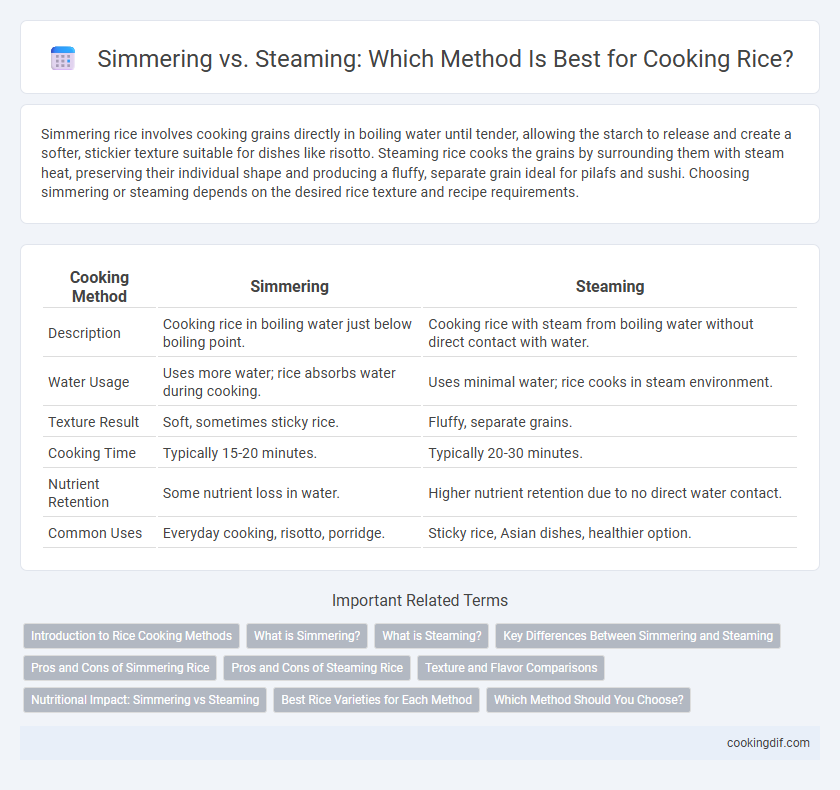Simmering rice involves cooking grains directly in boiling water until tender, allowing the starch to release and create a softer, stickier texture suitable for dishes like risotto. Steaming rice cooks the grains by surrounding them with steam heat, preserving their individual shape and producing a fluffy, separate grain ideal for pilafs and sushi. Choosing simmering or steaming depends on the desired rice texture and recipe requirements.
Table of Comparison
| Cooking Method | Simmering | Steaming |
|---|---|---|
| Description | Cooking rice in boiling water just below boiling point. | Cooking rice with steam from boiling water without direct contact with water. |
| Water Usage | Uses more water; rice absorbs water during cooking. | Uses minimal water; rice cooks in steam environment. |
| Texture Result | Soft, sometimes sticky rice. | Fluffy, separate grains. |
| Cooking Time | Typically 15-20 minutes. | Typically 20-30 minutes. |
| Nutrient Retention | Some nutrient loss in water. | Higher nutrient retention due to no direct water contact. |
| Common Uses | Everyday cooking, risotto, porridge. | Sticky rice, Asian dishes, healthier option. |
Introduction to Rice Cooking Methods
Simmering rice involves cooking grains in boiling water at a low, steady temperature to absorb liquid gradually, yielding a soft and fluffy texture. Steaming rice uses indirect heat with steam vapor, preserving more nutrients and delivering a distinct, separate grain consistency. Both methods cater to different rice types and culinary preferences, ensuring optimal texture and flavor based on cooking needs.
What is Simmering?
Simmering rice involves cooking it in water at a temperature just below boiling, typically around 185-205degF (85-96degC), allowing the grains to absorb moisture slowly and cook evenly. This method ensures a tender texture by maintaining gentle bubbles that prevent the rice from sticking or breaking apart. Simmering is ideal for dishes requiring a soft, fluffy consistency, as the controlled heat promotes thorough cooking without excessive evaporation.
What is Steaming?
Steaming rice involves cooking grains by exposing them to steam vapor rather than boiling them directly in water, which preserves nutrients and enhances texture. This method typically uses a steaming basket or specialized equipment to maintain consistent moisture without submerging the rice, resulting in fluffy, separate grains. Steaming is preferred for delicate rice varieties like basmati or jasmine, where maintaining individual grain integrity and subtle aroma is essential.
Key Differences Between Simmering and Steaming
Simmering rice involves cooking it in boiling water where the grains absorb moisture directly, resulting in a softer, stickier texture, while steaming rice uses indirect heat and steam to cook the grains, producing a fluffier, separate texture. Simmering requires more water and constant monitoring to prevent burning or sticking, whereas steaming typically uses less water and allows for more even cooking without direct contact. The choice between simmering and steaming impacts nutrient retention and texture, with steaming often preserving more vitamins and minerals due to gentler cooking conditions.
Pros and Cons of Simmering Rice
Simmering rice offers the advantage of consistent heat distribution, allowing the grains to absorb water evenly and resulting in a tender texture. However, this method requires careful attention to avoid overcooking or burning, as low heat can lead to uneven moisture retention and potential stickiness. Simmering also allows for flavor infusion by adding spices or broth, making it ideal for pilafs and seasoned rice dishes.
Pros and Cons of Steaming Rice
Steaming rice preserves more nutrients and creates a fluffier, less sticky texture compared to simmering, making it ideal for dishes requiring separate grains. It requires a precise amount of water and specialized equipment like a steamer, which can be less convenient and time-consuming for everyday cooking. However, steaming minimizes nutrient loss and avoids overcooking, enhancing the rice's natural flavor and nutritional profile.
Texture and Flavor Comparisons
Simmering rice produces grains that are softer and stickier due to direct water absorption, enhancing the rice's natural starchiness and creating a creamier texture often preferred for dishes like risotto. Steaming rice, on the other hand, preserves the individual grain integrity, resulting in a fluffier texture with more distinct grains and a subtle, nutty flavor profile, ideal for pilafs or sushi. Texture and flavor outcomes differ significantly between these methods, influencing the suitability of simmering or steaming based on the desired culinary result.
Nutritional Impact: Simmering vs Steaming
Simmering rice causes more nutrient loss, particularly water-soluble vitamins like B-complex and minerals, as they leach into the cooking water that is often discarded. Steaming preserves a higher nutrient content by cooking rice with minimal water contact, retaining both vitamins and minerals within the grains. For maximizing the nutritional value of rice, steaming is the preferred method due to its efficiency in conserving essential nutrients.
Best Rice Varieties for Each Method
Long-grain rice varieties such as Basmati and Jasmine perform exceptionally well with simmering due to their ability to absorb water evenly without becoming mushy. Short-grain rice types, including Sushi and Arborio, are ideal for steaming as their higher starch content creates a stickier texture perfect for dishes requiring a tender, cohesive bite. Medium-grain rice like Calrose can be versatile but typically achieves the best consistency when steamed, maintaining firmness while retaining moisture.
Which Method Should You Choose?
Simmering rice involves cooking grains directly in water just below boiling, allowing starches to release and produce a soft, sticky texture ideal for dishes like risotto or sushi. Steaming rice, by contrast, uses indirect heat to cook grains evenly without excess water, preserving firmness and individual grain integrity preferred for biryani or fried rice. Choose simmering for creamy, cohesive textures and steaming for fluffy, separated grains, depending on the desired rice dish and culinary tradition.
Simmering vs Steaming for rice cooking Infographic

 cookingdif.com
cookingdif.com